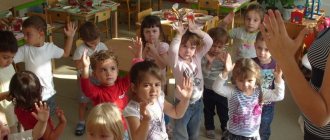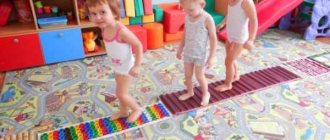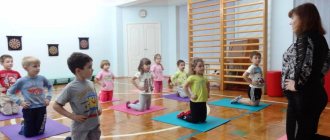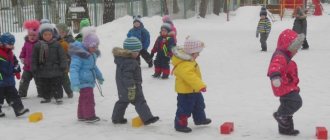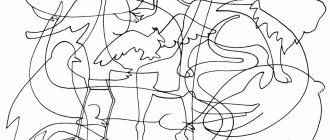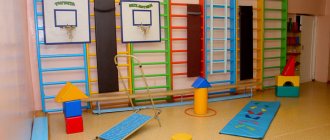Gymnastics according to A. N. Strelnikova for children from 4 years old
Alexandra Nikolaevna Strelnikova – teacher-vocalist. When she became seriously ill, she suffered an attack of suffocation, and acting gymnastics helped her. Her entire technique is based precisely on this gymnastics. Subsequently, the teacher began to help people strengthen their bodies, and help patients recover from various ailments.
In preschool educational institutions, Strelnikova’s breathing exercises have become widespread; her catalog of exercises includes many different techniques and techniques that allow children to fight colds and perfectly strengthen the immune system.
The complex should be performed following several rules:
- The most important aspect of gymnastics is inhaling through the nose (it is noisy and sharp).
- You need to exhale through your mouth, calmly and smoothly.
- Each specific movement is accompanied by an inhalation.
- Each exercise has a specific, clear rhythm. It is comparable to a drill march.
Exercise “Palms” or “Fists”
This exercise is a warm-up exercise.
- The child is in the most comfortable position for him.
- The child bends his arms at the elbows, palms facing forward.
- At the command of the leader, the child inhales and at the same time clenches his hands into fists.
- This is followed by a short pause (about 5 seconds), then repeating all actions several times.
If dizziness occurs, you should relax, sit down, and increase the pause time.
"Pogonchiki" or "Driver"
The child's hands are clenched into fists and placed in the middle of the abdomen. At the same time, you should pay attention that the rest of the body should not be tense (especially the shoulders). With a rapid inhalation, the child sharply pushes his fully straightened arms towards the floor. Afterwards the child returns to the starting position. 8 times is the recommended amount to perform.
"Pump" or "Pump"
The exercise is performed standing. Legs slightly apart. At the command of the leader, the child makes a slight tilt, and in the second half inhales sharply through the nose. The inhalation ends with the bend. After this, the child needs to rise slightly and perform the tilting movement again.
We should not forget that each exercise is performed in the rhythm of a marching step. The manager needs to monitor the rounded back of the wards, as well as the level of inclination - it should not be too low. This exercise should be performed 12 times.
"Hug your shoulders" or "Hug yourself"
During this exercise, the child seems to hug himself with bent arms. Raising them to shoulder level, he inhales sharply and hugs himself. 12 times is the amount recommended for performing the exercise.
The manager needs to find out whether there are children with heart defects and coronary heart disease. The exercise should not be performed with such a disease.
"Kitty"
In a standing position, the child begins to perform dance squats. The turn to the right is accompanied by a short inhalation, and at this moment the hands make grasping movements. The same goes for turning to the left.
Repeat 12 times. The leader pays attention to light, springy squats and relaxed, voluntary exhalation. During squats, your feet do not need to be lifted off the floor; all actions are performed with a straight back.
"Head turns"
The content of this exercise includes turning your head. The neck is relaxed at this moment, and each turn is accompanied by an inhalation.
Repeat the exercise 12 times.
The purpose and significance of breathing exercises
The most important goal pursued by supporters of breathing exercises is the general strengthening and healing of the child’s body.
Leading experts recommend using techniques based on breathing exercises as often as possible, as they:
- enrich the body with oxygen;
- are an excellent method to help a child control his breathing;
- improve the functioning of all internal organs;
- allow the child to become calmer and avoid stressful situations;
- have a preventive focus, making it possible to make the baby’s immunity more resistant to various colds.
Hatha yoga gymnastics for children over 5 years old
To introduce children to a healthy lifestyle, many teachers use such modern techniques as hatha yoga. Its implementation makes it possible to improve the physical and mental abilities of children and instill in them a culture of health.
Breathing exercises, which have an extensive catalogue, together with a rational regimen, proper nutrition and hardening in kindergarten, give excellent results.
More specifically:
- The number of children suffering from acute respiratory infections and influenza is decreasing.
- Children experience an increase in vitality.
- Memory and physical development improves.
- Children cope better with mastering the program.
- Increases communication skills and endurance.
Exercise "Snake"
Children sit in a comfortable position. The right hand closes the left nostril, and inhalation occurs through the right.
Then the right nostril is closed and exhalation occurs through the left. The teacher needs to use various imitation techniques: a breeze, a hurricane, inflating a balloon.
"Divers"
The teacher uses a game situation: children imagine that they are brave divers who dive in search of sunken ships. It is necessary to find suitable pictures, video clips and entertaining stories. This exercise teaches children to hold their breath. Needs to be repeated several times.
"Ball"
Starting position – lying down. The teacher asks the children to focus on breathing and take a deep breath, inflating their chest “like a balloon.”
This exercise helps children get used to breathing through their diaphragm.
"Wind"
The teacher asks the children to imagine that a warm summer breeze flew through their window. Children take a deep breath through their nose and exhale with the sound “U”. Then the teacher says that a cold wind has blown, the children inhale through their noses, and as they exhale, close their teeth tightly and say “Aah.”
What is breathing exercises?
Breathing exercises are a set of exercises aimed at developing and strengthening the body’s respiratory system. Prescribed for therapeutic and prophylactic purposes. Gymnastics is widely used as part of complex therapy in the treatment of diseases, as well as for general health improvement in children of preschool and school age.
Breathing exercises help prevent colds and bronchitis, recover from pneumonia and strengthen the child’s immunity. Developing the respiratory system increases the body's endurance during physical activity and improves brain function.
With regular exercise, lung volume increases and the respiratory muscles are strengthened. People suffering from bronchial asthma experience a reduction in the frequency of attacks.
REFERENCE! Breathing exercises saturate the child’s brain cells with oxygen - this helps him remember information better and participate more actively in the learning process.
Games and exercises for breathing in verses
In kindergarten, exercises from the card index of breathing exercises in verse are actively used.
Breathing exercises in kindergarten. Card file of exercises in verse
While performing this technique, it is important for the manager to observe:
- Children inhale through their nose.
- For complete relaxation of the shoulders.
- As you exhale, it is moderate and relaxed.
- Behind the cheeks - they should not puff up.
- Based on the general condition of the child - if dizziness occurs, exercises should be stopped.
Exercise "Football"
To perform the exercise, you need a small ball and a goal (can be made from a construction set). The child’s task is to “score” a goal into the goal. The tongue should be on the lower lip at this moment.
Before the exercise, the child recites the lines of the poem:
- “My cheerful ringing ball” (during the first acquaintance with the exercise, the line is pronounced by the leader);
- “Where did you start galloping?” (then the actual execution of the exercise occurs, and after it it is necessary to
Indications and rules for conducting classes
Breathing exercises in kindergarten, a card index of various techniques for different ages - a mandatory requirement for preschool employees. Venue – any; It is very useful to carry out the complex on the street, but if weather conditions do not allow, the complexes are carried out in a group with a teacher, or in music classes.
There are contraindications for some exercises. There are few of them, but the teacher needs to consult with the children’s parents to determine if they have chronic diseases.
- The exercise schedule ranges from 10 minutes to half an hour. The complexes should be performed only an hour after meals.
- A variety of toys and other demonstration materials should be used in such classes. This will increase children's motivation and interest in exercise.
- Using standard sets of exercises, you can modify them by adding something of your own and making them original.
- When weather conditions permit, it is imperative to perform the complex outdoors. If gymnastics takes place indoors, its temperature should not exceed 20 degrees.
- To achieve the best results, it is necessary to familiarize the children’s parents with the exercises so that they can practice regularly at home.
